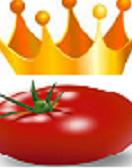Burned spots on tomato plant leaves can be a result of too much fertilizer or improper fertilizing practices and appears as scorching that begins at the edges of the leaves. The leaf edges look dried out,and eventually brown and brittle. To avoid root injuries that lead to leaf burn, do not allow fertilizers to come in direct contact with the plant’s stem or roots.
Scorch from FertilisersIf you water using a branded liquid feed, please follow the dilution instructions carefully and use half strength on small plants. You can start watering once you see the first trussed forming. Double strength fertiliser will not make your plants grow twice as fast, it will kill them.
If you are using a home-made fertiliser with Comfrey or nettles, then please make sure it is well diluted or you could burn the roots and leaves.
If you are applying fertilizers in a granular form, gently fork it into the soil about with 4 to 6 inches from the plant’s stem and be very careful not to damage the plants roots as they are close to the surface.By doing this they plant will not receive all the nutrients in one go, thoroughly water the fertiliser in following the application and repeat the process every 10 days or so.
Sometimes you can get leaf scorching from residue in the compost you maybe using, either the slow release fertiliser was not mixed in enough, or the manure you used to make compost was not rotted down enough.
Sun Scorch Seedlings are very prone to scorch if allowed to dry out at any-time. As they are usually in small pots there is little reserve for the roots so they do dry out very quickly on hot days, so could need a light water a couple of times a day until,they are transplanted to a larger plot. Sometimes with a sudden change in the weather it can be worthwhile adding a little shade to young plants on very hot days in early spring.

This cucumber plant is showing signs of leaf burn. As you can see it starts on the tip of the leaf and sometimes spreads to the rest of the leaf, especially with young leaves. You do not need to remove the leaf at this stage, but it much of the leaf is damaged than it is better to remove it. I would say that this particular leaf burn was caused by the plant being slightly too dry on a hot day, but it difficult to distinguish between sun burn and fertiliser scorch.
 This young tomato plant has quite severe scorch and you can see that the two lower seedling leaves have shrivelled up, so it is best to remove them. The upper part of the plant is nice and green so they problem has past and no real long term damage will occur. Scorch usually appears at the start of the season on young plants and is easy to spot as it starts on the tips of the leaves and is dry and crisp.
This young tomato plant has quite severe scorch and you can see that the two lower seedling leaves have shrivelled up, so it is best to remove them. The upper part of the plant is nice and green so they problem has past and no real long term damage will occur. Scorch usually appears at the start of the season on young plants and is easy to spot as it starts on the tips of the leaves and is dry and crisp. 
This is a severe case of cucumber leaf scorch, the dried leaves around the base of the plant are Comfrey leaves and this could have causes a high concentration of potash around the roots if there are more Comfrey leaves below ground around the roots system, or again too little water on hot days with a small root system.
Check out my posts on growing indoor cucumbers

